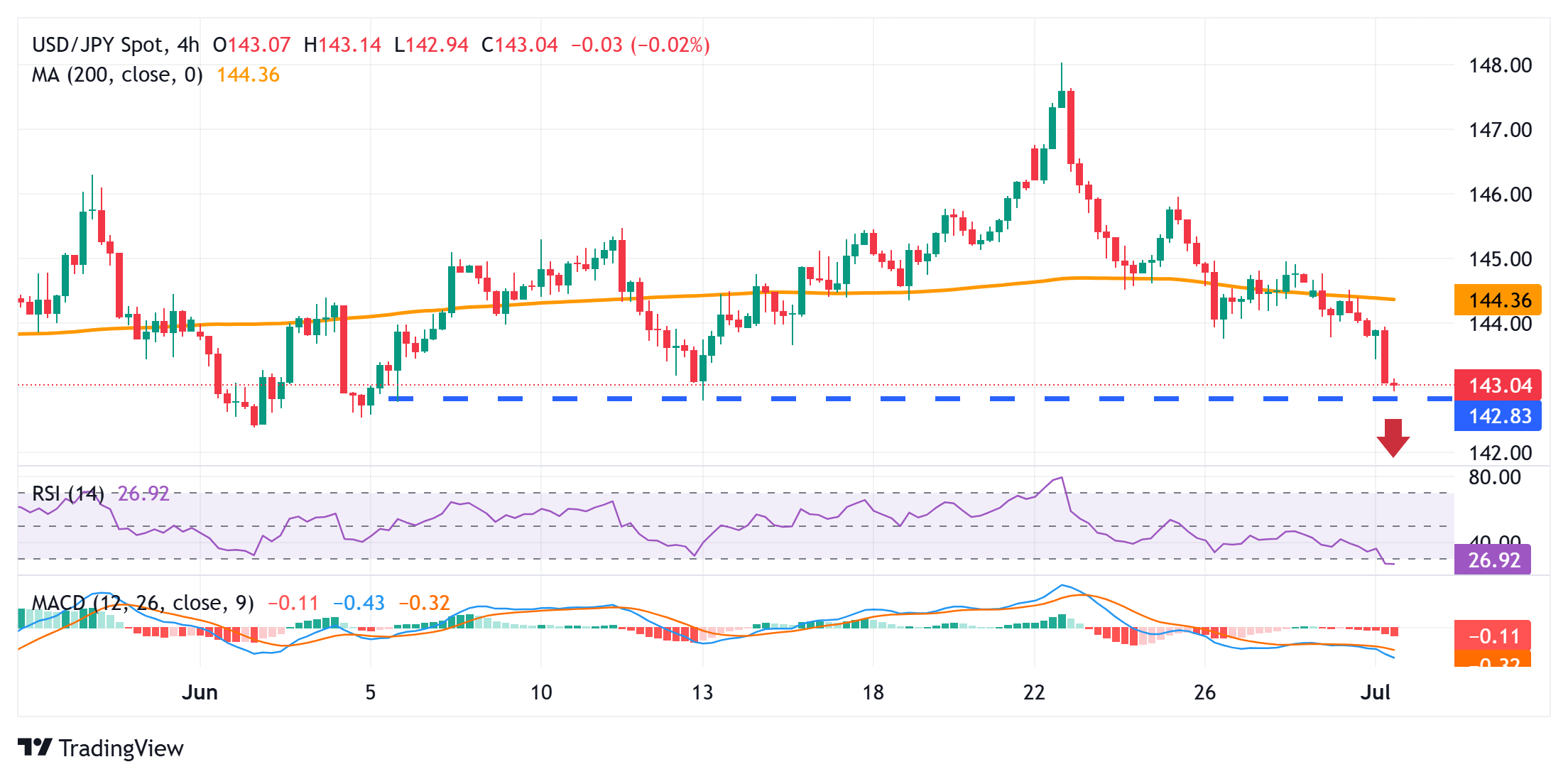
- USD/JPY attracts heavy selling on Tuesday and is pressured by a combination of factors.
- The divergent BoJ-Fed policy expectations turn out to be a key factor weighing on the pair.
- Traders seem rather unaffected by the risk-on environment and stalled US-Japan trade talks.
The USD/JPY pair drifts lower for the second successive day and drops to a nearly three-week low, around the 143.00 mark on Tuesday. Moreover, the fundamental backdrop supports prospects for an extension of the recent rejection slide from the 148.00 mark, or the highest level since May 13 touched last Monday.
The Bank of Japan’s (BoJ) Tankan Survey showed this Tuesday that business confidence at large manufacturers in Japan rose to 13.0 in the second quarter from 12.0 in Q1, above the market consensus for a reading of 10.0. Moreover, the outlook index came in at 12, stronger than the 9 expected and unchanged from the previous quarter. Additional details from the report revealed that firms expect consumer prices to rise by 2.4% over the next three years and by 2.3% annually over the next five years. This adds to concerns about mounting inflationary pressure in Japan, which reaffirms bets that the BoJ will raise interest rates further and provides a goodish lift to the Japanese Yen (JPY).
The US Dollar (USD), on the other hand, slides to its lowest level since February 2022 in the wake of the growing acceptance that the Federal Reserve (Fed) would resume its rate-cutting cycle in the near future. In fact, traders are currently pricing in a smaller chance that the next rate reduction by the Fed will come in July and see a roughly 74% probability of a rate cut as soon as September. The bets were reaffirmed by the US Personal Consumption Expenditures (PCE) report released on Friday, which showed that consumer spending unexpectedly declined in May. This, to a larger extent, overshadowed a modest uptick in the headline PCE and the core Price Index for May.
Moreover, US President Donald Trump stepped up his pressure campaign on Fed Chair Jerome Powell to lower borrowing costs in a handwritten note on Monday. Hence, investors will closely scrutinize Powell’s speech at the European Central Bank’s (ECB) Forum on Central Banking 2025 in Sintra for cues about the Fed’s rate-cut path. In the meantime, concerns about the worsening US fiscal condition should keep the USD bulls and the USD/JPY pair on the defensive. However, the uncertainty over Trump’s trade policies ahead of his July 9 deadline could limit any further JPY gains and help limit further losses for the currency pair, warranting caution before placing fresh bearish bets.
Japan’s top negotiator, Ryosei Akazawa, returned after the seventh round of talks in Washington without a deal. However, Akazawa said that he remains committed to reaching an agreement while safeguarding Japan’s economic interests. Trump expressed frustration over stalled US-Japan trade negotiations and also lashed out against Japan over its alleged unwillingness to buy American-grown rice. Moreover, Trump hinted at potentially ending trade talks with Tokyo and said that he may move ahead with the 25% tariff on Japanese autos. This, in turn, warrants caution before positioning for a further depreciating move for the USD/JPY pair ahead of important US macro releases.
A rather busy week kicks off with the release of the US ISM Manufacturing PMI and Job Openings and Labor Turnover Survey (JOLTS) later this Tuesday. The focus, however, will remain glued to the closely-watched US monthly employment details on Thursday. The popularly known Nonfarm Payrolls (NFP) report will play a key role in influencing the near-term USD price dynamics and provide some meaningful impetus to the USD/JPY pair.
USD/JPY 4-hour chart

Technical Outlook
Some follow-through selling below the 142.80-142.75 area (June 13 low) would set the stage for deeper losses. Given that oscillators on the daily chart have just started gaining negative traction, the USD/JPY pair might then accelerate the fall toward the May monthly swing low, around the 142.15-142.10 region. Some follow-through selling below the 142.00 mark could make spot prices vulnerable to test sub-141.00 levels.
On the flip side, the 143.35-143.40 zone could act as an immediate hurdle, above which the USD/JPY pair could reclaim the 144.00 mark. Any further move up might still be seen as a selling opportunity and remain capped near the 200-period Simple Moving Average (SMA) on the 4-hour chart, currently pegged near the 144.40 region. A sustained strength beyond the latter, however, would trigger a short-covering rally and lift spot prices to the 145.00 psychological mark.
Information on these pages contains forward-looking statements that involve risks and uncertainties. Markets and instruments profiled on this page are for informational purposes only and should not in any way come across as a recommendation to buy or sell in these assets. You should do your own thorough research before making any investment decisions. FXStreet does not in any way guarantee that this information is free from mistakes, errors, or material misstatements. It also does not guarantee that this information is of a timely nature. Investing in Open Markets involves a great deal of risk, including the loss of all or a portion of your investment, as well as emotional distress. All risks, losses and costs associated with investing, including total loss of principal, are your responsibility. The views and opinions expressed in this article are those of the authors and do not necessarily reflect the official policy or position of FXStreet nor its advertisers. The author will not be held responsible for information that is found at the end of links posted on this page.
If not otherwise explicitly mentioned in the body of the article, at the time of writing, the author has no position in any stock mentioned in this article and no business relationship with any company mentioned. The author has not received compensation for writing this article, other than from FXStreet.
FXStreet and the author do not provide personalized recommendations. The author makes no representations as to the accuracy, completeness, or suitability of this information. FXStreet and the author will not be liable for any errors, omissions or any losses, injuries or damages arising from this information and its display or use. Errors and omissions excepted.
The author and FXStreet are not registered investment advisors and nothing in this article is intended to be investment advice.








